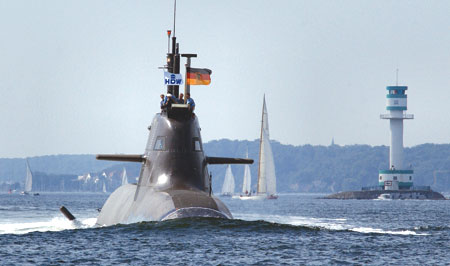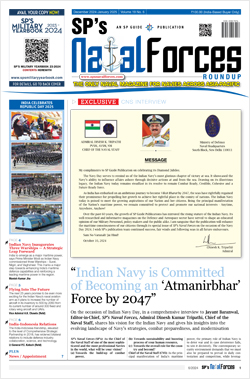
Endurance of a conventional submarine being an important limiting factor, R&D in the field of submarine propulsion systems dominates the future trends in conventional submarines
Though various types of sub-marines were developed over a period of time, submarines truly proved their worth during the Second World War, and emerged as one of the most potent and stealthy naval platforms. The U-boat menace forced the affected forces to employ tactics to coun-ter the deadly threat. Many developments in submarine technology like snorkel for charging batteries at periscope depth, HF Communication, Radar, Sonar, Direction Finding systems, high performance batter-ies, and so on influenced submarine tactics and their effectiveness. After the Second World War, research and development in submarine technology continued in various spheres ranging from propulsion, design features to modern day weapons.
Conventional diesel-electric submarines need to rise to periscope depth periodi-cally to recharge their batteries by using generators driven by air breathing diesel engines, making them indiscrete. During this evolution, submarines are most vulner-able to detection by enemy forces. The quest to overcome this inherent vulnerability resulted in extensive research and experiments in the field of Nuclear and Air Independent Propulsion (AIP). This led to significant breakthroughs in the field of submarine propulsion. Research and devel-opment in other spheres too continued concurrently. The arsenal of conventional submarines now includes modern day sophisticated torpedoes, smart mines and sub-launched missiles controlled by state-of-the-art combat systems.
The technologically advanced sonar suite aided by low self-noise of quieter submarines provides the conventional sub-marines enhanced sensor ranges in most tactical scenarios. However, endurance of a conventional submarine being an important limiting factor, research and development in the field of submarine propulsion systems dominated the future trends in conventional submarines. This article draws the spotlight on the future trends in the submarine pro-pulsion systems, their research and devel-opment and future applications.
AIP Concept
Incorporating technologies that allow a sub-marine to operate in the depths of the ocean without the need to plane to periscope depth to access atmospheric air for battery charging, the term AIP usually excludes the use of nuclear power and describes augmenting the diesel electric propulsion system of conventional submarines. AIP is usually implemented as an auxiliary source and is not a primary independent source of propulsion. Most such systems generate electricity, which in turn drives an elec-tric motor for propulsion or recharges the submarine’s batteries. The electrical power generated is also used to meet the hotel load requirements of the submarine such as for ventilation, lighting, and so on.
One of the prominent characteristic of AIP systems is that it can be retrofitted into existing submarine hulls by inserting an additional hull section or a plug. AIP does not normally provide the endurance or power to replace the diesel generators which run on atmospheric air and are essential for battery charging, but allows it to remain submerged longer than a mere convention-ally propelled submarine. It is a strap-on and one time in a mission capability boost which needs to be recharged in harbour.
Research and development in AIP tech-nology has gained momentum among sub-marine designers across the world. Various AIP concepts which have undergone development or are in the process of being developed are:
• Closed Cycle Diesel Engine
• Stirling Engine
• Fuel Cells
• Closed Cycle Steam Turbine—MESMA
Closed Cycle Diesel Engine
A Closed Cycle Diesel Engine (CCDE) can be operated in its conventional mode on the surface and at periscope depth while snorting (wherein air is ingested from the atmosphere). In the submerged configura-tion, the diesel engine runs air which is created from stored oxygen and argon. The exhaust is cooled and then chemi-cally scrubbed in an absorber to remove carbon dioxide. Argon is recovered and is fed back for reuse. The engine exhaust is replenished with oxygen in the mixing chamber before being fed into the intake manifold of the diesel engine, thereby completing the closed loop of the diesel engine. The remaining exhaust gas is mixed with seawater through a water man-agement system to minimise the creation of bubbles and related noise levels and is eventually discharged overboard.
Closed cycle diesel uses a standard diesel engine and is based on a simple technology providing same efficiency as that of a conventional diesel engine. Additional components required for CCDE can be retrofitted in the existing diesel engine of a conventional submarine. The storage of liquid oxygen in cryogenic double jacket tanks and Argon is an area of concern because of related safety issues. Since CCDE is a diesel engine, it is as noisy in its operation and produces as much heat as any conventional diesel engine. This is a major disadvantage with regard to the acoustic and infrared signa-ture management of a conventional subma-rine. Stealth being a key characteristic of a conventional submarine, the acoustic and infrared signature due to CCDE would play an important role in the selection of CCDE as a viable AIP option. The management of these two signatures is likely to be the pri-mary areas for research and development in the field of CCDE AIP system.
Stirling Engine
Stirling Engine, in principle, is an external combustion engine, in which heat generated from an external source is applied to a con-tained quantity of working medium, generally an inert gas like helium. The engine consists of an expansion and compression piston. Heat generated by burning oxygen and die-sel in a pressurised combustion chamber is transferred to the working gas. This forces the gas to work against a piston, thereby produc-ing mechanical energy. The gas is thereafter drawn into a compression chamber for com-pression and the compressed gas exposed to heat, thereby increasing the pressure at con-stant volume. Subsequently, the gas expands in expansion space and works on the expan-sion piston. Thus, the heat energy is con-verted to mechanical energy. This mechanical energy can be utilised to generate electricity for either propulsion or for charging batteries of a conventional diesel electric plant.
The engine exhaust is disseminated overboard by a water management system. However, the acoustic signature of the sub-marine is anticipated to be higher due to exhaust discharge. Like the CCDE, liquid oxygen is stored in cryogenic tanks and determines the endurance of the submarine using Stirling Engine AIP. The efficiency of Stirling Engines is likely to be lesser than that of CCDE. The Swedish Kockums Naval Systems have successfully developed Stirling Engine and the same have been fitted onboard Gotland Class submarines. Stirling Engine’s operational utilisation onboard conventional submarines could make it a fea-sible choice for prospective AIP systems.









